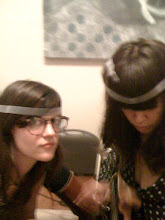 H BOX at MUDAM (Musee d'Art Moderne Grand-Duc Jean, Mudam Luxembourg).
H BOX at MUDAM (Musee d'Art Moderne Grand-Duc Jean, Mudam Luxembourg).I.M. Pei architect design.
Photo by Andres Lejona.
Thinking back to 2008, I remember how excited I was about Zaha Hadid's Mobile Art Unit, which came to NYC-- Central Park to be exact-- for the Chanel Exhibition. Ideologically, this concept was ripe with potential, but ultimately, it failed content wise. Going beyond it's haute-couture breathren Chanel, Hermes has a foundation set up, which funnels profits into stimulating the cultural economy; focusing on supporting young artists and designers in the beginning of their careers, and soliciting responses to pressing issues in the global economy in which the luxury brand operates. H Box (Could have come up with a more creative name) is one of these endeavors. Curated by international media impressario Benjamin Weil, H Box has been commissioning four artists a year to produce single-channel video for the collapsible screening room since 2006. The mobile unit, designed by Didier Daustino travels around the world, and the works are updated on a yearly basis.
The show had one foot in commercial and promotion, and the other in runway imagination; but there wasn't a hint of creative inspiration. I left feeling like I was supposed to want to buy into their visual branding aesthetic--but couldn't because there was clearly a us vs. them divide throughout the show. It was clear that at no point was the exhibition or the works therein intended to inspire creative or independent thought. Intentional or not, I felt undercurrents of brainwashing (the show was narrated and viewers had no option on this front) and outlandish marketing schemes (each work supplanted the male gaze, so common in traditional Art History, with a feminine desire for social mobility and mindless consumption.)

H Box is smaller and therefore more concise. Focusing solely on video; a distributable, disposable, and portable medium; the content of the show is appropriate for the parameters and concept of the project. AND MOST IMPORTANTLY: The content of the videos speak to a larger curatorial mission, extending beyond flagrant and distasteful product placement which is both respectful and respectible.
According to e-flux, "21 videos by artists from all over the world have been produced, and H BOX has screened in major museums and art centers in Europe and North America (USA and Mexico). It was also presented at the Yokohama Triennale in 2008 and will travel to Beijing and Guangzhou later in 2011. The H Box itself is an object that blends a screening room, a travel kit, and a modern curio cabinet of sorts. It creates a specific context for the viewing of exciting new works by artists who, for the most, have lived and worked in numerous places, and often have a multiplicity of cultural references and bases."
www.
2011 H BOX program
Rosa Barba
(Born in 1972 in Sicily, lives and works in Germany)
The Empirical Effect, 2010
16mm transferred to HD Cam
20min.
Ali Kazma
(Born in 1971 in Turkey, lives and works in Turkey)
Taxidermist, 2010
Digital Video, color and stereo sound
13 min.
Mark Lewis
(Born in 1958 in Canada, lives and works in Canada)
TD Centre, 54th Floor, 2009
Single screen projection 35mm and 4K transferred to 2K
6min. 18sec.
Julika Rudelius
(Born in 1968 in Germany, lives and works in Netherlands)
Dressage, 2009
HD video transferred DVC pro
8min. 40sec.
Nikhil Chopra and Munir Kabani
(NC: Born in 1974 in India, lives and works in India)
(MK: Born in 1976 in India and works in India)
Man Eats Rock, 2011
HD-CAM mastered tape
20min.
Omer Fast
(Born in 1972 in Israel, Lives and works in Germany)
Sunday Morning (Part III of the Tunnel), 2010
HD video with sound
5min. 30sec.
Hwayeon Nam
(Born in 1979 in Korea, lives and works in Korea)
Do not harm your ghost, 2010
HD video transferred HD-CAM, color and stereo sound
17min. 56sec.
Wang Jianwei
(Born in 1958 in China, lives and works in China)
Zero, 2010
HD video transferred to digital beta, color and stereo sound
18min.
Curator: Benjamin Weil
Benjamin Weil has worked on the H BOX project since its inception. Working in close collaboration with the Hermès team, he has conceptualized the project and participated in its implementation. Since the beginning he has also selected the artists whose work have been commissioned (to date H BOX has commissioned 21 works in its 5 years of existence).
Architect: Didier Fiuza Faustino
Didier Fiuza Faustino is an artist and architect. In 1996 he set up the Laboratoire d'Architecture, Performances et Sabotages (l.a.p.s.), and in 2002 founded Bureau des Mesarchitectures.
Fondation d'entreprise Hermès
The Fondation d'entreprise Hermès was founded in April 2008. Within the framework of its support for contemporary artistic creation, it sets the programme schedules for six art spaces worldwide (Brussels, Tokyo, New York, Singapore, Seoul, Bern) and produces their exhibitions. This ensemble of galleries devoted to contemporary art and photography has been completed by H Box, dedicated exclusively to showing video art all over the planet. The Fondation d'entreprise Hermès is also committed to several project sponsors in the spheres of solidarity and culture.
www.

No comments:
Post a Comment